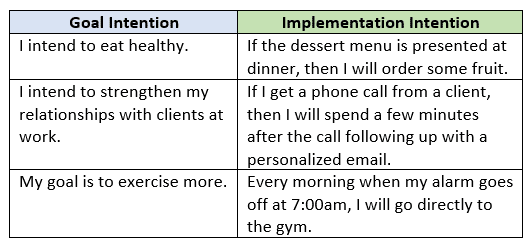Make it a Habit to Keep Your Resolutions
As the New Year begins, many of us will engage in the common practice of forming both personal and professional resolutions and goals. While the tradition of “New Year’s Resolutions” dates back thousands of years, this practice has evolved from its original focus of reflecting on the past year to the current practice of focusing on future self-improvement endeavors. However, as we all know too well, whether your resolution is switching to a healthier lifestyle or learning a new skill, the simple formation of a goal does not guarantee success.
Why Goals Don’t Stick:
Simply creating a list of personal goals can be ineffective. Koestner and colleagues (2002) offer three main reasons why:
- Poorly structured goals: Goals are often too ambiguous, difficult, or in conflict with one another.
- Reasoning behind goals: People often set goals for external reasons (e.g., social pressures and expectations), rather than reflecting on their own interests and personal values.
- Lack of specific plans: Once a goal is “set”, people often fail to specify when the goal pursuit will be initiated and how they will persist when obstacles and distractions arise.
Expectations Matter. Schmidt and Dolis (2009) suggested that the extent to which someone believes they can attain their goals has an important impact on whether she/he will persist or disengage from a goal. For example, if a person has multiple competing goals and achieving both goals is probable, effort and time will likely be dedicated to the goal that is further away from attainment. However, if reaching both goals is unlikely, individuals tend to devote their time and effort to the goal closest to being met. As an example, based on a predetermined deadline, if I believe I can meet my goal of increasing my sales by 5%, but do not think I can reach my goal of improving my customer satisfaction scores by 5 points within the same time frame, I will narrow my focus on reaching my sales goal and drop progress toward the customer satisfaction metric. Based on our goal expectations, the old saying “whether you think you can, or think you can’t – you’re right” rings true.
What affects our expectations? Expectations of whether we will achieve goal success are influenced by several factors. Researchers (Klein et al., 2008) show that beyond simply having the knowledge, skills, and experience to effectively achieve our goals, individuals make connections regarding their behaviors and the outcomes they receive, which contribute to whether or not they expect success. For example, when a stable association is made (e.g., If I work more hours, I will make more money), individuals will have greater confidence that their behavior will contribute to attaining their goals. However, when attributions are unstable (e.g., When I eat more vegetables, sometimes I lose weight, but sometimes I do not), it is difficult to feel confident about how behavior is related to goal attainment. When a goal is set, it is important to think about how our expectations impact success.
How Can I Reach my Goals?
Based on this research and the common anecdotal breaking of New Year’s resolutions, it’s no secret that goal attainment is difficult. Gollwitzer (1999) suggested that one of the key breakdowns in achieving our goals is flexibility, meaning if we are too flexible with our goals, commitment to them may decrease. If people do not spend time considering the ways they will implement their goals (e.g., when, where, how) prior to goal pursuit, they are likely to fail when it comes to making quick decisions about the goal. Gollwitzer’s implementation intentions are different from goal intentions (i.e., achievement of desired outcome), because implementation intentions specify the what, when, where, and how of goal attainment. It is important to consider these questions and create a plan to ensure goal success.

Implementation intentions may sound silly at first, but forming these plans as “mini-triggers” in your mind can help you (1) recognize the opportunity to act on your goal and (2) actually commit to the action. If you’ve set an intention by telling yourself you’ll get out of bed as soon as the alarm goes off and head to the gym, the decision has already been made – you’re committed, and you’re more likely to actually do it. You’re well on your way to forming the habit to keep your resolutions.
What implementation intentions will you set to kick off the New Year? Key things to remember:
- Keep goals specific, time-bound, and at an appropriate level of difficulty.
- In writing a list of goals, make sure to include the details: When does goal pursuit start? What obstacles will I likely face? How will I overcome those obstacles?
- Remember the difference between a goal intention (desired outcome) and an implementation intention (specify the when, where, and how that will lead to goal attainment).

References
Gollwitzer, P. M. (1999). Implementation intentions: Strong effects of simple plans. American psychologist, 54(7), 493.
Klein, H. J., Austin, J. T., & Cooper, J. T. (2008). Goal choice and decision processes. In R. Kanfer, G. Chen, & R. D. Pritchard (Eds.), The organizational frontiers series: Vol. 27. Work motivation: Past, present, and future (pp. 101-150). New York: Routledge/Taylor & Francis Group.
Koestner, R., Lekes, N., Powers, T. A., & Chicoine, E. (2002). Attaining personal goals: self-concordance plus implementation intentions equals success. Journal of Personality and Social Psychology, 83(1), 231-244.
Schmidt, A. M., & Dolis, C. M. (2009). Something’s got to give: The effects of dual-goal difficulty, goal progress, and expectancies on resource allocation. Journal of Applied Psychology, 94(3), 678-691.